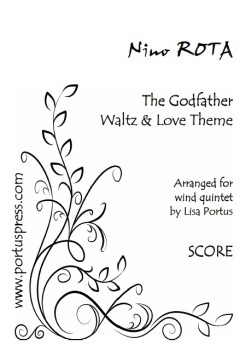
All Portus Press music for winds – whether that’s my wind quintet music or arrangements for wind quintet and piano, wind quartet , wind trio, bassoon quartet or bassoon choir is fun to play – and audiences love.
Believe me, as a bassoonist I’ve played many arrangements in the past where the bassoon is stuck solely on the bass line whilst the flute hogs the melody line and everyone else ‘fills in’ the parts imbetween.
That is so, SO boring. But it needn’t be that way!
As a both an experienced chamber musician and arranger of many years I know exactly how to turn great music into an imaginatively arranged, interesting and satisfying piece, providing music that every member of your ensemble will enjoy playing.
My customer testimonials speak volumes – but here’s a bit of ‘inside information’ as to what my aims are and how I go about doing what I do ….
How I choose what music to arrange
When I arrange a piece of music a huge amount of thought goes into it before I’ve even begun.
Firstly, I’m very fussy about what music I choose to arrange. As well as being great music, it’s got to suit wind instruments. For example, there’s a great deal of brilliant string music out there. Fantastic though it is, much of it could never successfully be turned into music for woodwind instruments. Likewise very ‘pianistic’ piano pieces and many (but not all!) large-scale symphonic works just won’t translate into really good music for winds.
Despite my fussiness you’ll be amazed at the variety on offer in my various catalogues. With music ranging from Praetorius to the Pink Panther – and Bach to the Beatles – my arrangements cover a vast array of styles. Something to suit all tastes and abilities (from Grade 4 up).
Much of my wind quintet music and arrangements for other wind groups is of unashamedly popular music (the Beatles titles are especially popular): this always goes down well and is great for encores and background music. But there are also a number of substantial, serious musical works.
How I go about arranging a piece of music?
This is where the fun really starts!
I have been arranging music for many, many years but, still, every single new piece I arrange presents fresh challenges.
If there’s an orchestral score of a piece I’ll often work solely from that. For wind quintet and piano pieces I will also refer to a piano version if there is one too. Sometimes piano versions (especially if they are by the composer themselves) are useful anyway.
A good amount of the music I arrange is of works that were written with prominent wind parts. If there are famous solos I will usually assign them to the original instrument a) because that’s what players will probably expect and b) why try and reinvent the wheel! In fact I often try to incorporate the original orchestration to retain the instrumental colours as originally intended by the composer.
But clearly, that’s not always possible, or appropriate, and with such small ensembles I have to cover as much of the original harmony as I practicably can. I listen a great deal to recordings to get the essence of what I’m trying to recreate – and listen intently to my arrangements to ensure that they live up to expectations too. Listening and adjusting is absolutely crucial to the process.
Not all of the music I arrange is orchestral: many of my titles were originally for piano solo, or were just for strings (but being careful what I select) … and there are pop songs too. They require a different and often more creative approach – and I’m not averse to slotting in additional or linking material. With no orchestral score to work from I have full liberty to assign whatever music I like to each instrument. This demands an in-depth knowledge of each instrument and how they work in combination. Experience is one thing – but, again, listening is crucial.
… but – not every arrangement I attempt works!
Creating a finely crafted and balanced arrangement is a hugely enjoyable – and time-consuming – process. I have to be absolutely sure that I am happy with the end product before releasing it to the outside world in publishing it. However, not every arrangement I have done has met my stringent standards. Those that just don’t work well enough are shelved and never published.
Something for everyone
In creating great music for winds one of my main aims is to ensure that all parts have something interesting to do: this is absolutely crucial in my mind to making sure every player enjoys what they’re playing. Everyone – almost without exception (although I can’t think of any off-hand) – has a ‘go’ at the melody line, or at the very least a satisfying counter melody. The bassoon is absolutely not consigned to sit on the bass line – it too has the chance to shine. Nor is the horn stationed on the ‘pah-pah’ fillers!
Sharing out the interesting parts also means that other instruments have a bit of a break – which is very much needed in such small ensembles. Rests are – for that very reason – also included in each player’s part: not just for page-turns (which are carefully thought out) but just to have a much-needed breather wherever possible!
 Beautiful presentation
Beautiful presentation
There’s very little point in creating a finely crafted and expertly arranged piece if the presentation is not up to scratch! All of my pieces are professional laser-printed on quality paper in A4 stapled booklets with distinctive imagery and branding. All page turns are well thought-out and a set of programme notes is included that you’ll hopefully find informative and perhaps useful in a concert setting when you want to give your audience a bit of background information about a piece.
Most of my titles are also available as an instantly downloadable PDF which are designed to be printed by you at home in A4 or US Letter format.
What about bassoon quartets?
Much of my approach is very similar to that I adopt with my other arrangements. But clearly, with four identical instruments the only ‘colours’ available are those inherent in the bassoon – with its varied characters across the registers. It is precisely that that I harness when arranging for bassoons. Also, there’s an even greater opportunity to mix the parts around. Just like in my wind quintet music, in my bassoon quartets the 1st bassoon doesn’t get all the melodies whilst the 4th bassoon languishes at the bottom of the pack. Yes, the bassoon one has the most difficult part and bassoon four the easiest, but the melody (and bass) lines are spread out amongst all parts.
Ready to explore? Why not check out what’s on offer in my online shop …
